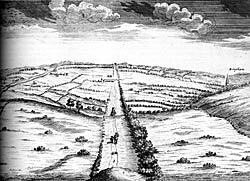
|
|
|
Subject overview
 |
| View by William Stukeley of the Fosse Way from Cotgrave Hill (1722). |
Roads are a key product of the settlement and regular use of the landscape, through the need of humans to undertake regular journeys between two or more locations. The course a road takes is due to a number of factors, especially the topography of the landscape traversed, the mode of travel and the purpose of the journey. Rivers form the most difficult type of landscape to traverse and reference should also be made to the Research Pathway on Rivers for more information on road bridges.
This subject is frequently considered in a number of phases: prehistoric tracks, Roman roads, mediaeval roads, the turnpike trust era (18th & 19th centuries) and the modern road system for motor vehicles. In many cases later redevelopment of the same stretch of road will have obliterated the earlier evidence.
The following publications provide the key general reference works on the subject from a national point of view:
- I D Margary, Roman roads in Britain (1973)
- Christopher Taylor, Roads & tracks of Britain (Dent, 1979)
- B Hindle, Roads, tracks and their interpretation (1993)
- B Hindle, Mediaeval roads and tracks (1998)
- W Albert, The turnpike road system in England (1972)
The nature & location of resources
Road systems have been poorly researched and written about by historians, and primary written sources are not abundant.
© THOROTON SOCIETY | CREATED: 7 March 2003 | UPDATED: 6 July 2003